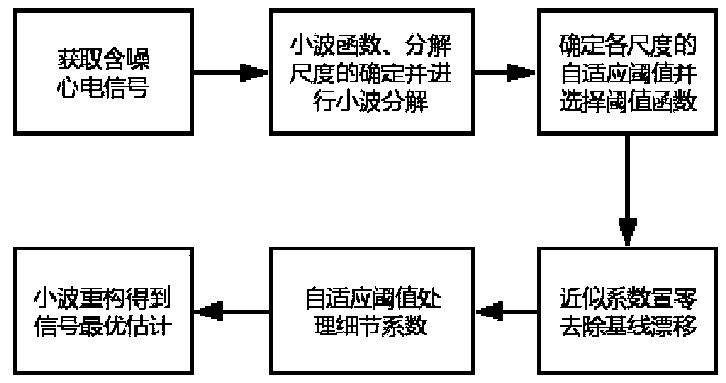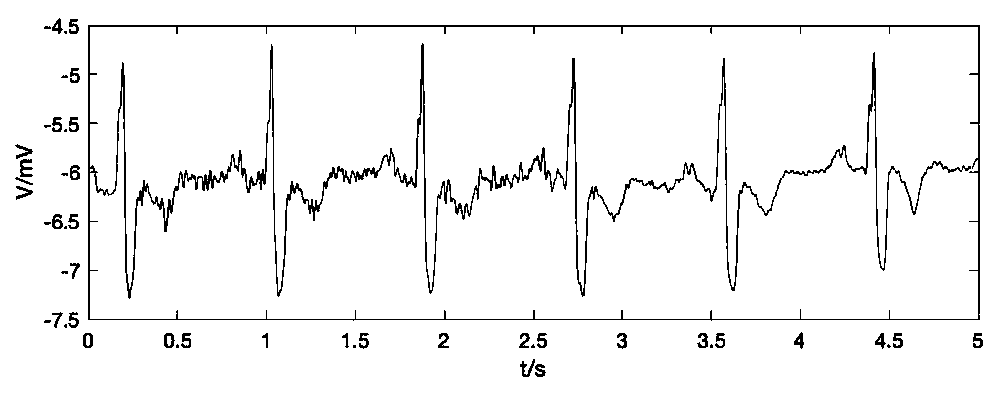Electrocardiographic signal de-noising method based on adaptive threshold wavelet transform
An adaptive threshold, ECG signal technology, applied in applications, electrical digital data processing, special data processing applications, etc., can solve the problems of strangling wavelet coefficients, poor reconstruction and smoothing effect, easy to produce oscillations, etc. Separation, high practical value, the effect of retaining detailed information
- Summary
- Abstract
- Description
- Claims
- Application Information
AI Technical Summary
Problems solved by technology
Method used
Image
Examples
Embodiment 1
[0040] The ECG signal denoising method based on adaptive threshold wavelet transform of the present invention, the operation in Matlab comprises:
[0041] Step 1: Obtain noisy ECG signals: select the first 1800 data of No. 118e_6 data in the MIT-BIH noise database to carry out qualitative analysis experiments; draw the original waveform diagram of the selected data in Matlab ( figure 2 ) and spectrogram ( image 3 ), as a comparative reference figure after using the traditional method and the method of the present invention for denoising respectively;
[0042] Step 2: select the wavelet function φ(x) and the number of decomposition layers J, and carry out wavelet decomposition to the noisy ECG signal: the present invention selects the sym6 wavelet function similar to the ECG signal form; 118e_6 data sampling rate 360Hz, useful signal 90 % is concentrated in 0.5-40Hz, and the baseline drift interference is mainly concentrated in the low frequency part within 1Hz, so 8-layer w...
Embodiment 2
[0065] ECG signal noise reduction method based on adaptive threshold wavelet transform, the operation in Matlab includes:
[0066] Step 1: Obtain the noisy ECG signal, select 1800 data from 20 seconds to 25 seconds of No. 103 data in the MIT-BIH arrhythmia database as the original "pure" signal, and superimpose three common interferences on it. First superimpose a sinusoidal signal with a frequency of 60Hz and an amplitude of 0.02mV to simulate power frequency interference, then use the awgn() function to superimpose random Gaussian white noise with a specified signal-to-noise ratio to simulate EMG, and finally superimpose the frequency at 0.3Hz and an amplitude of 0.2mV The sine signal simulates the baseline drift, so as to obtain the experimental data to be denoised; when superimposing random white noise, white noise with different signal-to-noise ratios is added, and the processing results are different. In this embodiment, the signal-to-noise ratio after superimposed noise ...
PUM
 Login to View More
Login to View More Abstract
Description
Claims
Application Information
 Login to View More
Login to View More - R&D
- Intellectual Property
- Life Sciences
- Materials
- Tech Scout
- Unparalleled Data Quality
- Higher Quality Content
- 60% Fewer Hallucinations
Browse by: Latest US Patents, China's latest patents, Technical Efficacy Thesaurus, Application Domain, Technology Topic, Popular Technical Reports.
© 2025 PatSnap. All rights reserved.Legal|Privacy policy|Modern Slavery Act Transparency Statement|Sitemap|About US| Contact US: help@patsnap.com



